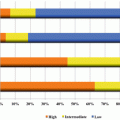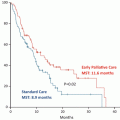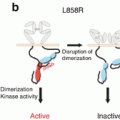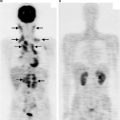Author (study name)
Year
Radiation (Gy/fractions)
Chemotherapy
N of patients
Overall survival
Grade 3–4 pneumonitis (%)
Treatment-related death (%)
Induction
Concurrent
Consolidation
Median (month)
2y rate (%)
Hallqvist A (SATELLITE)
2011
68/34
CDDP+DTX
Cetuximab
None
75
17.0
37.0
4.2
1.4
Ramalingam SS
2013
73.5/35
None
Cetuximab
CBDCA + PTX
38
19.4
25.0
0
2.6
van den Heuvel MM
2014
66/24
None
Daily cisplatin
None
51
NR
58.0
0
0
66/24
None
Daily cisplatin + cetuximab
None
51
NR
62.0
11.8
3.9
Blumenschein GR (RTOG 0324)
2011
63/35
None
CBDCA + PTX + cetuximab
CBDCA + PTX + cetuximab
93
22.7
49.3
16.1
6.5
Govindan R (CALGB 30407)
2011
70/35
None
CBDCA + PEM
PEM
48
21.2
48.0
12.0
4.0
70/35
None
CBDCA + PEM + cetuximab
PEM
53
25.2
50.0
11.3
5.7
Liu D
2015
60–66/30–33
CDDP + DTX + cetuximab
CDDP + DTX + cetuximab
None
27
26.7
51.9
0
0
9.3 EGFR Tyrosine Kinase Inhibitors
EGFR tyrosine kinase inhibitors (TKIs) are another class of agents that inhibit EGFR, especially EGFR with somatic mutations in its tyrosine kinase domain [29, 30]. The EGFR mutations sensitize tumor cells to ionizing radiation by 500- to 1000-fold through the delayed repair of DNA double-strand breaks when compared with EGFR wild-type tumor cells [31, 32]. Several lines of studies showed that gefitinib and erlotinib potentiated radiation effects in NSCLC with EGFR wild type in vitro and in vivo by suppressing cellular DNA repair capacity and G2/M phase cell cycle arrest [33–38]. For EGFR-mutated cells, there are no experimental studies that tried to investigate the interaction between EGFR-TKIs and radiation.
There are several feasibility and phase II trials of EGFR-TKIs combined with thoracic radiotherapy or chemoradiotherapy in patients with unresectable stage III NSCLC (Table 9.2) [39–45]. These studies showed that these attempts were all feasible with acceptable toxicity, but the efficacy was disappointing in all but one trial. Komaki R et al. reported a phase II trial of erlotinib concurrently with weekly carboplatin and paclitaxel chemotherapy and thoracic intensity-modulated radiation therapy at a total dose of 63 Gy in 35 fractions followed by carboplatin and paclitaxel chemotherapy in 46 patients with previously untreated unresectable stage III NSCLC [45]. In the amended protocol, the primary endpoint of this study was time to progression, and the authors hypothesized that combining erlotinib and chemoradiation would increase the median time to progression from 15 to 25 months. The survival results looked promising at a glance; the median OS in this study was 36.5 months, and 2- and 5-year OS rates were 67.4 % and 35.9 %, respectively. None of these survival parameters differed by EGFR mutation status. The time to progression, however, was only 14 months with a distant failure noted in 59 % of patients. They concluded that the time to progression did not meet the assumption and more effective systemic therapy was needed.
Table 9.2
Epidermal growth factor receptor-tyrosine kinase inhibitors: feasibility and phase II trials
Author (study name) | Year | Radiation (Gy/fractions) | Chemotherapy | N of patients | Mutated EGFR (%) | Overall survival | Grade 3–4 pneumonitis (%) | Treatment-related death (%) | |||
|---|---|---|---|---|---|---|---|---|---|---|---|
Induction | Concurrent | Consolidation | Median (month) | 2y rate (%) | |||||||
Feasibility trials | |||||||||||
Stinchcombe TE | 2008 | 74/37 | CBDCA + PTX + CPT | CBDCA + PTX + gefitinib | Gefitinib | 23 | NR | 16.0 | 20.0 | 4.8 | 0 |
Okamoto I | 2011 | 60/30 | Gefitinib | Gefitinib | Gefitinib | 9 | 25 | 6.3 | 33.0 | 11.1 | 0 |
Rothschild S | 2011 | 63/34 | CDDP + GEM or CBDCA +PTX | Gefitinib | Gefitinib | 5 | NR | 12.6 | NR | 0.0 | 0 |
CDDP + gefitinib | Gefitinib | 9 | NR | 11.1 | 0 | ||||||
Choong NW | 2008 | 66/33 | None | CDDP + ETP + erlotinib | DTX | 17 | NR | 10.2 | 25.0 | 5.9 | 0 |
CBDCA + PTX | CBDCA + PTX + erlotinib | none | 17 | NR | 13.7 | 20.0 | 0.0 | 0 | |||
Phase II trials | |||||||||||
Ready N (CALGB30106) | 2010 | 66/33 | CBDCA + PTX | Gefitinib | Gefitinib | (Poor risk) 21 | 28.9 | 19.0 | 32.0 | 9.5 | 4.8 |
66/33 | CBDCA + PTX | CBDCA + PTX + gefitinib | Gefitinib | (Good risk) 39 | 13.0 | 26.0 | 10.3 | 5.1 | |||
Niho S (JCOG0402) | 2012 | 60/30 | CDDP + VNR | Gefitinib | Gefitinib | 38 | NR | 28.1 | 65.4 | 3.0 | 0 |
Komaki R | 2015 | 63/32 | None | CBDCA + PTX + erlotinib | CBDCA + PTX | 48 | 9.8 | 36.6 | 67.4 | 8.3 | 0 |
Another approach to unresectable stage III NSCLC is to add an EGFR-TKI as a maintenance therapy after completion of a standard chemoradiotherapy. A phase III trial of maintenance gefitinib or placebo after concurrent chemoradiotherapy and docetaxel consolidation in unresectable stage III NSCLC showed that the gefitinib arm was inferior in overall survival to the placebo arm (median survival: 23 months versus 35 months, p = 0.013) [46]. This unexpected outcome could not be explained by excessive toxicity in the gefitinib arm, because grade 4 toxicity was noted only 2 % of patients and no toxic death in the gefitinib arm. One possible explanation was an imbalance in prognostic factors including smoking history, tumor EGFR mutation status, and K-ras mutation status, which might have contribution in poorer outcome in the gefitinib arm. Finally, the possibility that gefitinib somehow stimulated tumor growth either directly or indirectly cannot be excluded [47]. Erlotinib as maintenance treatment after concurrent chemoradiotherapy seemed also not promising in patients with stage III NSCLC not selected by EGFR mutations [48].
9.4 Angiogenesis Inhibitors
Angiogenesis is the essential process for further growth after tumors reach a diameter of 1–2 mm to maintain blood supply to the tumors. Angiogenesis is also critical for the efficacy of radiotherapy through several mechanisms. Tumor vascular bed is abnormal and irregular in its structure and function with the incomplete and heterogeneous oxygen supply. This leads to hypoxic radioresistance of tumor cells through lack of oxygen to facilitate DNA damage by radiation-induced free radicals and upregulation of hypoxia-inducible factor-1α (HIF-1α) [49]. In addition, radiation directly induces HIF-1α expression in tumor cells. The HIF-1α renders tumor cell phenotype suitable for proliferation by transcriptionally activating several genes, as well as induces tumor cells to secrete vascular endothelial growth factor (VEGF) [50], which serves to enhance endothelial cell radioresistance and angiogenesis after radiation [51, 52]. It was shown that tumor response to radiotherapy was closely related to endothelial cell apoptosis [53].
The rationale of combining angiogenesis inhibitors and radiation is vascular normalization, the remodeling of a dysfunctional tumor vasculature to a normal phenotype to restore tumor perfusion and oxygenation, and inhibition of radiation-induced angiogenesis signaling for repopulation of tumor cells after radiation [54]. Numerous preclinical models showed synergistic effects of the two modalities in a dose- and schedule-dependent manner, probably because disruption of tumor vessels hampers proper perfusion and aggravates tumor tissue hypoxia [55–58]. Thus, the vascular normalization window, the transient period of vessel normalization during anti-angiogenesis therapy, is important for the clinical application of angiogenesis inhibitors during radiotherapy, but it is difficult to determine when the normalization window occurs in patients, because the tumor growth kinetics in patients differ from those in animal models [54].
Early clinical investigations of bevacizumab and chemoradiotherapy were closed early due to severe toxicity. A phase II trial of carboplatin, pemetrexed, and bevacizumab induction for two cycles followed by thoracic radiotherapy at a dose of 61.2 Gy in 34 fractions concurrently combined with the same chemotherapy in patients with stage III NSCLC showed that of five patients enrolled, two developed tracheoesophageal fistula, and one died of bilateral pulmonary hemorrhage, left ventricular dysfunction, and subsequent pneumonia [59]. Socinski et al. reported a phase I/II trial of carboplatin, paclitaxel, and bevacizumab for two cycles followed by chemoradiotherapy with weekly carboplatin, paclitaxel and biweekly bevacizumab, and thoracic radiotherapy at a dose of 74 Gy in 37 fractions. Patients in cohort 1 received no erlotinib, whereas patients in cohorts 2 and 3 also received erlotinib at 100 and 150 mg, respectively. Of 45 patients enrolled, one developed grade 3 pulmonary hemorrhage and another developed tracheoesophageal fistula [60]. A phase I trial of induction cisplatin-based doublet chemotherapy and subsequent thoracic radiotherapy to a total dose of 66 Gy in 33 fractions concurrently combined with escalating doses of bevacizumab showed that four of six patients developed pneumonitis [61]. These trials clearly showed that concurrent bevacizumab and thoracic radiotherapy was too toxic. Another feasibility trial of chemoradiotherapy followed by consolidation docetaxel and bevacizumab resulted in two grade 3 pneumonitis and two fatal pulmonary hemoptysis among 21 patients assessable for safety [62]. Thus, even after completion of chemoradiotherapy, bevacizumab develops serious toxicity.
Stay updated, free articles. Join our Telegram channel

Full access? Get Clinical Tree







